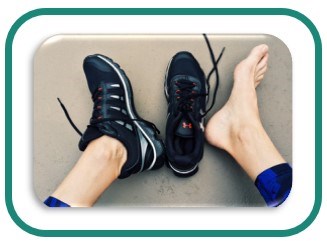Footwear advice to reduce the risk of amputation

Footwear and diabetes
This leaflet gives you advice about wearing the most appropriate shoes, taking account of the shape of your feet and your diabetes.
Footwear that does not fit properly is one of the most common causes of foot problems in people with diabetes.
Why is diabetes a risk to your feet?
The development of foot wounds in people with diabetes is serious as they are linked to an increased risk of heart attacks, strokes, amputations of the foot or leg and early death.
Controlling your diabetes, cholesterol and blood pressure, stopping smoking, increasing cardiovascular exercise and controlling your weight helps to reduce the risk of these life-and
limb-threatening problems.
Note: You may be at further risk of cardiovascular problems if you have a family history of heart disease.
If you develop any of the following problems, it is important that you contact your Multi-disciplinary Foot Care Team, local Podiatry Department or GP for advice as soon as possible (within 24 hours).
- A red, hot, swollen toe or foot
- A new break or wound in the skin
- New redness or discolouration of your toe or foot
- New or unexplained pain in your foot
If you discover any breaks in the skin or blisters, cover them with a sterile dressing. Do not burst blisters.
What can I do to reduce my risk of developing problems?
Check your feet every day
Check your feet every time you remove your shoes, stockings or tights and check for any redness or blisters.
Check your shoes
Check the bottom of your shoes before putting them on to make sure that nothing sharp such as a pin, nail or glass has pierced the outer sole. Also, run your hand inside each shoe to check that no small objects such as small stones have fallen in.
The shape of your feet
our feet can change shape over time, so when you buy shoes always check they fit carefully.
Buying new shoes
Get your feet measured
Get your feet measured and your new shoes fitted properly.
Well-fitting shoes
Make sure your shoes are long enough, deep enough and wide enough for your feet. If your shoes are too tight they will press on your toes.
Always try on both shoes
When buying new shoes, always try on both shoes. Most people’s feet are slightly different sizes.
Buy your own shoes
If possible you should go to the shoe shop yourself and not ask somebody else to buy your shoes for you.
Wear new shoes around the house
Wear new shoes around the house for short periods (20 minutes) and then check your feet. Look for problems such as redness caused by rubbing or pressure. If this happens, you can usually return shoes to the shop, but only if you have not worn them outside.
Advice on new shoes
If you are not sure if your new shoes are suitable, ask your podiatrist for advice before you wear them.
Recommended footwear
Types of shoes
A well-fitting shoe, boot or trainer with laces or a strap fastening will give your feet the best support. These fastenings will help to keep your foot firmly in place inside your footwear and help prevent rubbing.
Heel height
The heel of your footwear should not be more than 2.5 centimetres (1 inch).
Natural materials
Where possible the uppers (top) of your shoes should be made from a natural material such as soft leather. Leather will fit to your foot without causing any rubbing and will help to prevent your feet from swelling.
Check the condition of your prescribed footwear and have repairs done when necessary.
Wear and tear
Signs of wear and tear
Check your shoes for signs of wear such as rough edges in seams or linings, and worn soles and heels. Always check your shoes are in good condition and replace them whenever there are signs of wear and tear that can’t be repaired.
Prescription shoes
Prescription shoes
If you have been supplied with shoes, they will have been made to a prescription. You should follow the instructions your orthotist (the person who designed or prescribed your shoes) or podiatrist gives you. At first you should wear the shoes for short periods around your home, checking for any problems such as redness caused by rubbing or pressure. If this occurs, you should contact your podiatrist or orthotist immediately.
When you and the person who prescribed your shoes are happy with the comfort and fit of the first pair, you will be supplied with a second pair.
These should be the only shoes you wear. It is important that you wear these shoes inside and outside the house.
Shoes will normally be prescribed with insoles. These are an important part of your footwear and you should only remove them if your podiatrist or orthotist advises you to. It is important that you check the inside of your shoes every day to make sure no small objects have fallen in, and that there is no damage to the insole or lining.
If you notice any wear or damage to the shoes, you should contact your orthotist or podiatrist so that they can be repaired.
Whoever provided your shoes will advise you about any repairs or alterations to make sure that they still match your prescription.
Socks, stockings and tights
You should always change your socks, stockings or tights every day. They should not have bulky seams and they should not have elasticated tops. Some high-street shops sell suitable products - ask your podiatrist for details. All your socks, stockings and tights should be the right size for your feet.
Remember: if you are not sure about any shoes, socks, stockings or tights you are wearing, or new shoes you have bought, your podiatrist will be happy to advise you.
Resources:
Footwear advice to reduce the risk of amputation pdf